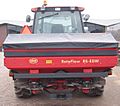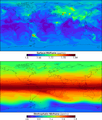Fertilizer facts for kids
A fertilizer is a special substance that helps plants grow big and strong. Think of it like a vitamin for plants! Plants need certain minerals from the soil to stay healthy. Over time, plants use up these minerals, or rain can wash them away. Fertilizers put these important minerals back into the soil.
Some common types of fertilizers include:
- Ammonia
- Manure (which is animal waste, and was one of the first fertilizers ever used!)
- Compost (made from decayed plants and food scraps)
- Urea
The most important things in fertilizer are three main nutrients:
- Nitrogen (N)
- Phosphorus (P)
- Potash (K)
When you buy fertilizer, you'll often see three numbers on the bag, like "9-23-30". These numbers tell you the percentage of Nitrogen (N), Phosphorus (P), and Potash (K) in the fertilizer. For example, 9-23-30 means 9% N, 23% P, and 30% K. Nitrogen helps plants grow green leaves. Phosphorus is great for flowers and roots. Potash helps with overall plant health and strong stems.
To know exactly what your plants need, you can do a soil test. This test checks the soil to see which nutrients are missing. Then you can choose the right fertilizer to help your plants thrive!
Contents
How Fertilizers Help Plants Grow
Plants need many different things to grow, just like you need food and water. They get most of their "food" from the soil. Fertilizers add key nutrients back into the soil, making it richer and better for plants.
Essential Plant Nutrients
The three main nutrients in most fertilizers are Nitrogen (N), Phosphorus (P), and Potassium (K). Each one plays a special role:
- Nitrogen (N): This nutrient is super important for making plants green and leafy. It helps plants grow strong stems and lots of leaves. Plants that you grow for their leaves, like lettuce or spinach, need plenty of nitrogen.
- Phosphorus (P): Phosphorus helps plants develop strong roots and beautiful flowers. It's also important for making fruits and seeds. If you want lots of flowers or a good harvest of fruits, phosphorus is key.
- Potassium (K): Also called Potash, potassium helps plants stay healthy overall. It makes them stronger, helps them resist diseases, and can even protect them from very hot or cold weather.
Understanding Fertilizer Labels
When you see numbers like 9-23-30 on a fertilizer bag, it's called the N-P-K ratio. These numbers tell you the percentage of each main nutrient. For example, a 9-23-30 fertilizer has 9% Nitrogen, 23% Phosphorus, and 30% Potassium. Knowing these numbers helps you pick the best fertilizer for what your plants need.
Using Fertilizers Safely
While fertilizers are great for plants, using too much can cause problems. It's important to use them carefully and follow the instructions.
Too Much Fertilizer
If you put too much fertilizer on a plant, it can actually harm it. This is sometimes called "fertilizer burn." The extra chemicals can dry out the plant's roots and leaves, making them turn brown and even die. Always use the right amount for your plants.
Fertilizers and the Environment
Sometimes, if too much fertilizer is used, or if it rains a lot, extra nutrients can wash away from farms and gardens. These nutrients can end up in rivers, lakes, and even the ocean. When this happens, it can cause problems for the environment. For example, too many nutrients can make algae grow very fast in water. When this algae dies, it uses up all the oxygen in the water, creating "dead zones" where fish and other water creatures can't survive. This is why it's important to use fertilizers wisely and only when needed.
Images for kids
-
Mirat, a company in Spain, has been making fertilizers since 1812!
-
An apatite mine in Siilinjärvi, Finland, where materials for fertilizers are dug up.
-
Applying superphosphate fertilizer by hand in New Zealand, 1938.
-
Global methane concentrations in 2005. Methane is a gas that can be released from some farming practices.
See also
 In Spanish: Fertilizante para niños
In Spanish: Fertilizante para niños












